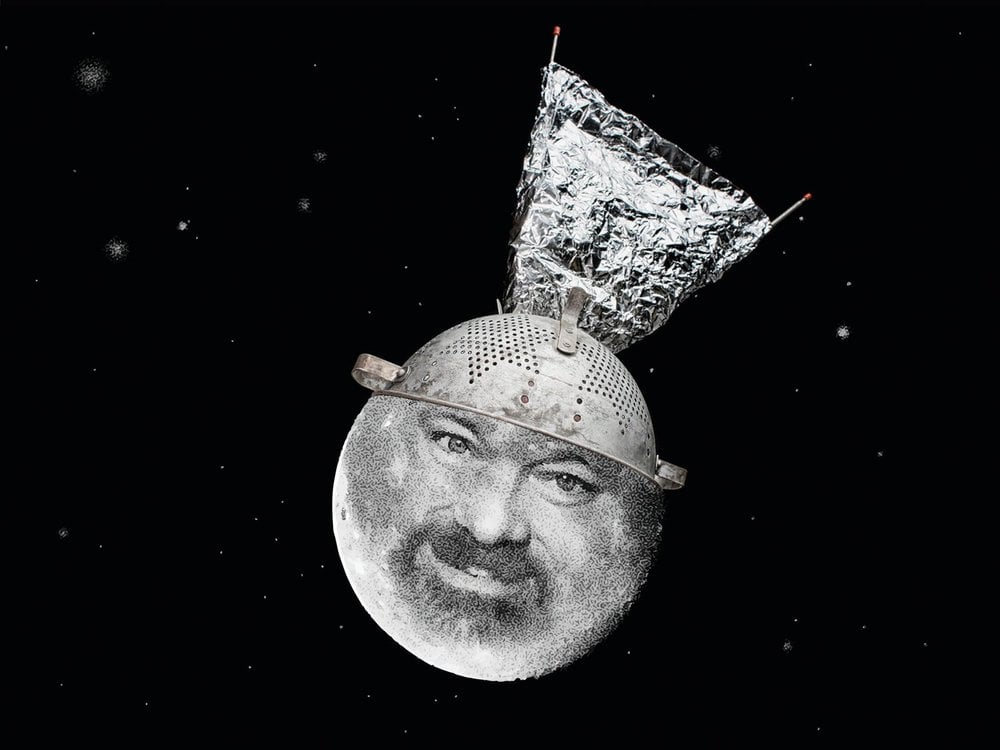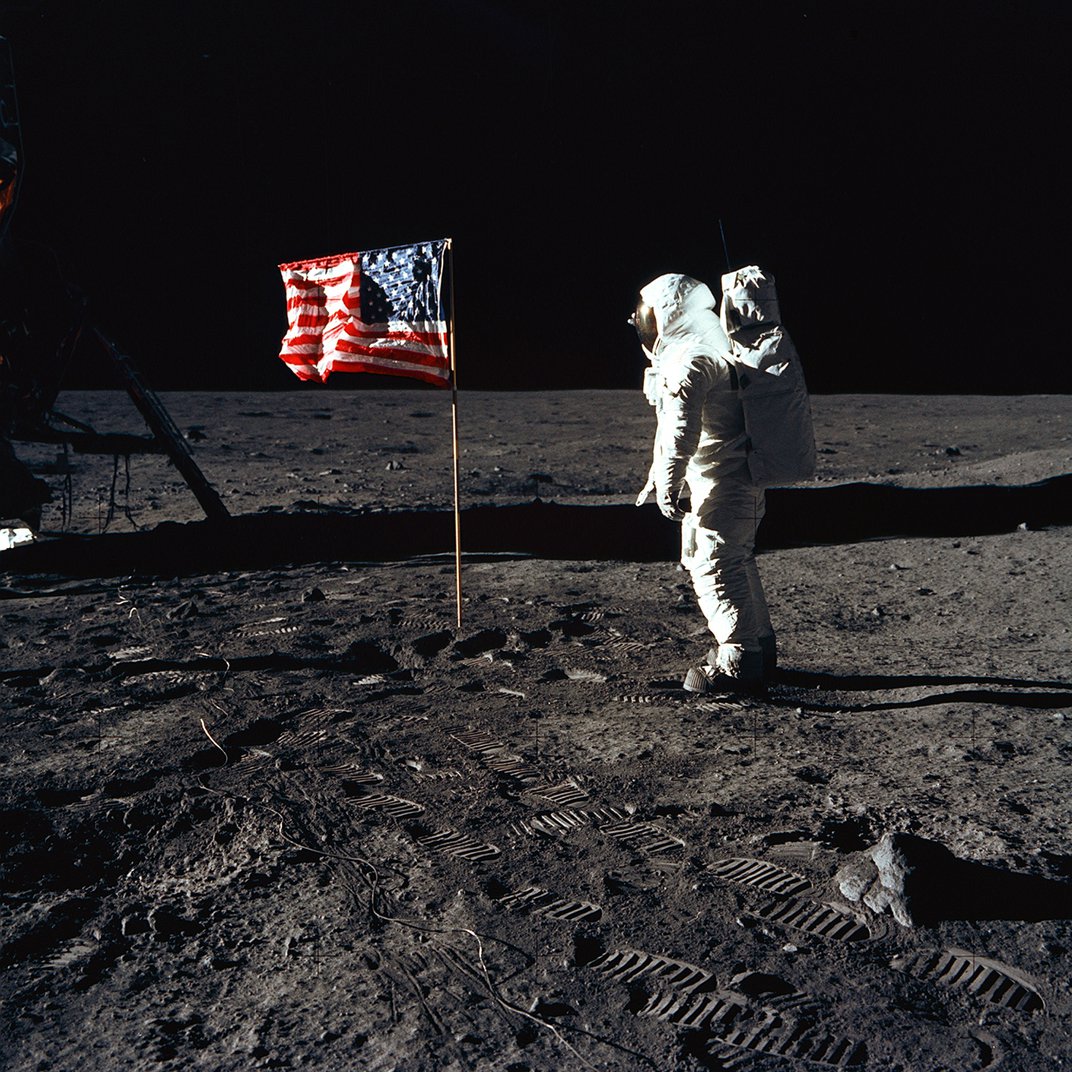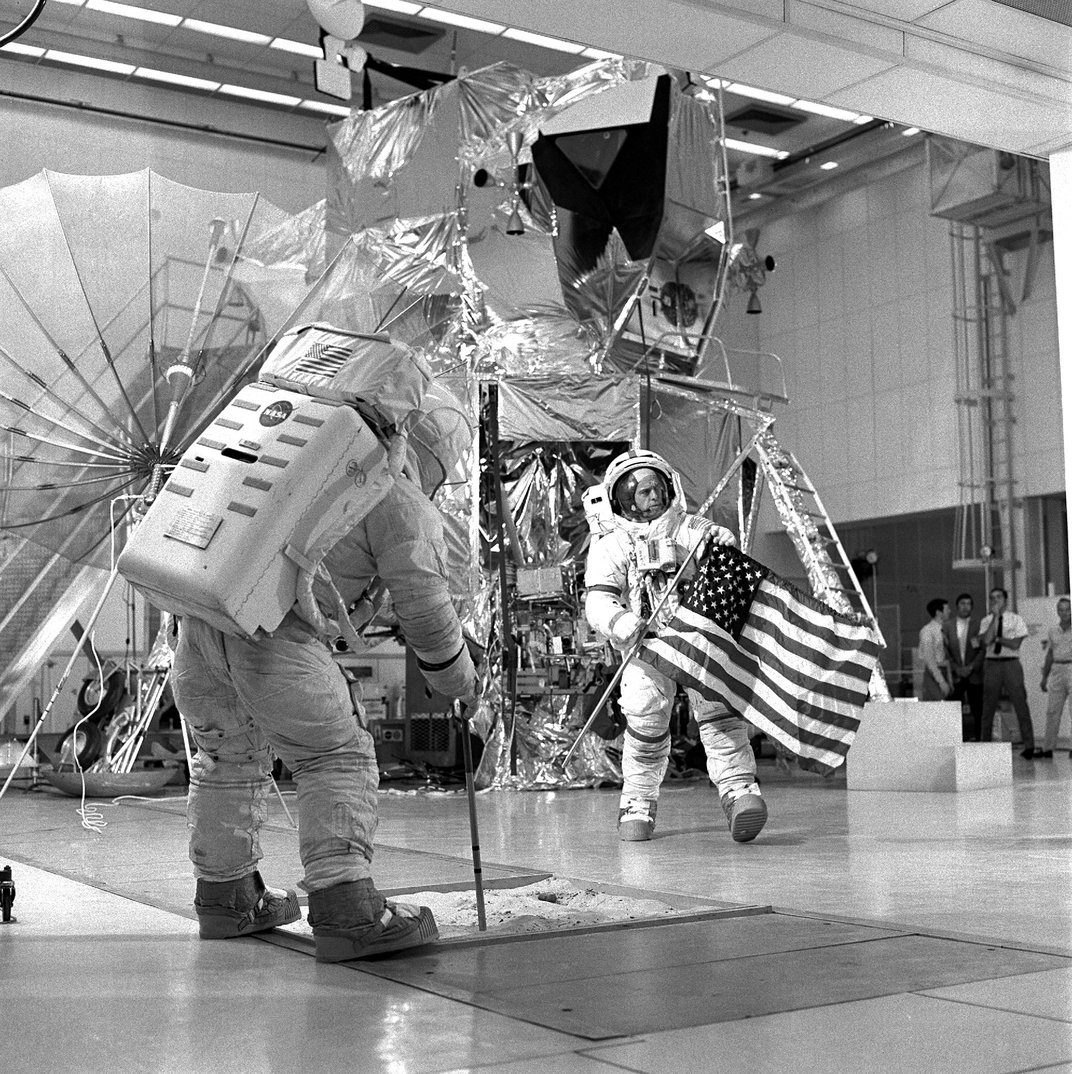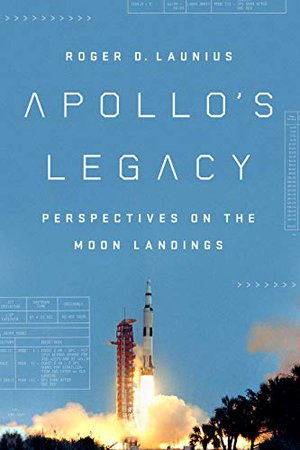Yes, the United States Certainly DID Land Humans on the Moon

My grandfather, Jeffrey Hilliard Launius, was a 75-year-old farmer from southern Illinois at the time of the first moon landing in 1969. He didn’t believe that Americans had landed on the moon. In his estimation such a technological feat was simply not possible. Caught up in the excitement of Apollo 11 that summer, I could not understand my grandfather’s denial. In his insular world, change came grudgingly, however, and a moon landing was certainly a major change. At the time of his death, in 1984, Jeff Launius remained unconvinced.
President Bill Clinton recalled in his 2004 autobiography a similar story of a carpenter he worked with in August 1969, not long after the Apollo 11 landing: “The old carpenter asked me if I really believed it happened. I said sure, I saw it on television. He disagreed; he said that he didn’t believe it for a minute, that “them television fellers” could make things look real that weren’t.”
New York Times science reporter John Noble Wilford remarked in December 1969 that “a few stool-warmers in Chicago bars are on record as suggesting that the Apollo 11 moon walk last July was actually staged by Hollywood on a Nevada desert.” The Atlanta Constitution led a story on June 15, 1970, with “Many skeptics feel moon explorer Neil Armstrong took his ‘giant step for mankind’ somewhere in Arizona.” While poll numbers questioning the moon landing in Detroit, Miami and Akron averaged less than 5 percent, among African-Americans in such places as Washington, D.C., a whopping 54 percent doubted the moon voyages. That perhaps said more about the disconnectedness of minority communities from the Apollo effort and the nation’s overarching racism than anything else. As the story reported, “A woman in Macon said she knows she couldn’t watch a telecast from the moon because her set wouldn’t even pick up New York stations.”
As historian Howard McCurdy opined, “To some, the thrill of space can’t hold a candle to the thrill of conspiracy.” An early and persistent theme has been that as a Cold War measure the United States could not afford to lose the race to the moon, but when failure loomed, NASA faked the landing to save face and national prestige. It used the massive funds dedicated to the effort to “pay off” those who might be persuaded to tell the truth; it also used threats and in some instances criminal actions to stop those who might blow the whistle.
Another common assertion has been that in the latter 1960s, with the U.S. government in disarray because of the debacle of the Vietnam War, the racial crisis in the cities, and social upheaval, the Apollo program proved an ideal, positive distraction from this strife, a convenient conspiracy designed to obscure other issues. One story published in 1970 stated this belief as expressed by an African-American preacher: “It’s all a deliberate effort to mask problems at home,” Newsweek quoted him saying. “The people are unhappy—and this takes their minds off their problems.”
The first conspiracy theorist to make a sustained case for denying that the U.S. landed on the moon was Bill Kaysing, a journalist who had been employed for a few years in the public relations office at Rocketdyne, Inc., a NASA contractor, in the early 1960s. His 1974 pamphlet We Never Went to the Moon laid out many of the major arguments that have been followed by other conspiracy theorists since. His rationale offered poorly developed logic, sloppily analyzed data and sophomorically argued assertions.
Kaysing believed that a failure to land on the moon sprang from the idea that NASA lacked the technical expertise to accomplish the task, requiring the creation of a massive cover-up to hide that fact. He cited as evidence perceived optical anomalies in some imagery from the Apollo program, questioned the physical features of certain objects in the photographs (such as a lack of a star field in the background of lunar surface imagery and a presumed waving of the U.S. flag in an airless environment), and challenged the possibility of NASA astronauts’ surviving a trip to the moon because of radiation exposure.
As John Schwartz wrote of the conspiracy theorists in the New York Times, “They examine photos from the missions for signs of studio fakery, and claim to be able to tell that the American flag was waving in what was supposed to be the vacuum of space. They overstate the health risks of traveling through the radiation belts that girdle our planet; they understate the technological prowess of the American space program; and they cry murder behind every death in the program, linking them to an overall conspiracy.”
Ted Goertzel, a professor of sociology at Rutgers University who has studied conspiracy theorists, told Schwartz that “there’s a similar kind of logic behind all of these groups.” For the most part, he explained, “They don’t undertake to prove that their view is true” so much as to “find flaws in what the other side is saying.” And so, he said, argument is a matter of accumulation instead of persuasion. “They feel if they’ve got more facts than the other side, that proves they’re right.”
Kaysing insisted, without any evidence whatsoever, that even though the Soviet Union was watching the American effort closely, it was easier to successfully fake it than actually to land on the moon. He even speculated that the chance of landing successfully on the moon stood at 0.017; on what this calculation was based is a mystery and does not square with NASA estimates at the time, which stood at approximately 87 percent for at least one successful landing before the end of the 1960s.
Some moon-landing deniers concede that there were robotic missions to the moon, but that the human Apollo landings were faked. Professional moon-landing denier Bart Sibrel has asserted that Apollo spacecraft crews had faked their orbit around the moon and their walk on its surface by using trick photography, but did accept Earth orbital missions. Humans could not go to the moon, Sibrel and deniers of his ilk claim, because going beyond the Van Allen radiation belts would have given them lethal doses of cosmic radiation. While there is indeed radiation both in the Van Allen belts and beyond, and radiation’s risks to human health are real, contentions that it would not be survivable are nonsense, and almost no papers in peer-reviewed scientific journals make this claim. A few conspiracy theorists in this category even allow that NASA landed robotically on the moon various passive reflector mirrors used for laser ranging and other human-made objects to bamboozle the public.
Then, there are those who believe that humans went to the moon, but did so with the assistance of extraterrestrial visitors—or that Apollo astronauts discovered extra-terrestrial life there. These claims ranged from gravitational anomalies to alien artifacts to alien encounters. Accordingly, this brand of conspiracy theorist claims that NASA covered up what had been found, in the manner of the discovery of a monolith at Clavius Crater on the Moon in 2001: A Space Odyssey.

Conspiracy theorist Richard Hoagland has asserted for many years that the Apollo program discovered large artificial glass structures on the lunar surface that has been kept from the public. Besides other conventions common in a cover-up, Hoagland made the claim that the astronauts that went to the moon had been hypnotized and any memories of extraterrestrial encounters were removed. Most interestingly, Hoagland has argued that NASA deviously orchestrated the origins of the moon-landing denials as a disinformation campaign to mask the discovery of extra-terrestrial structures on the lunar surface. In 2009, he asserted that the water molecules that NASA’s Lunar Reconnaissance Orbiter had discovered on the Moon had been leaked from buried extraterrestrial cities. No evidence supported these assertions.
While the various claims of the moon-landing deniers have evolved over time, their reasons for making these claims have rested on several types of “evidence.” The most significant are anomalies found in photographs or, to a much lesser degree, movies taken on the missions. Imagery has played a critical role in the communication of the experience. While Apollo imagery documented in graphic detail what took place on the moon, the use of that same imagery to raise questions about the entire enterprise is an irony too great to ignore.
Some 25 images have been invoked in such claims. These include images that do not show stars in the background, despite conspiracy theorists’ insistence that they should be clearly seen; the fact that dust was not present on the landing pads of the spacecraft; the assertion that shadows and lighting on the moon are uneven and counterintuitive to the photographs in which they are seen; that flags seem to be blowing in a breeze although there is no wind on the moon; that some rocks appear to have propmaster marks on them; and that Réseau-plate crosshairs sometimes seem to disappear behind objects in an image. For each of these charges, there are completely reasonable, understandable, and convincing explanations, most relating to the nature of photography and the vicissitudes of shadows, lighting and exposure of film in a vacuum. Few moon-landing deniers, however, will accept any explanation whatsoever. I have personally had one say to me, “Regardless of whatever you might say, I will never believe that humans have landed on the moon.”
Deniers of the moon landing also point to anomalies in the historical record to cast doubt on the NASA account of the Apollo program. One of the persistent beliefs is that the “blueprints” for the Apollo spacecraft and Saturn V rocket have been lost, or perhaps they never existed. This is simply untrue. The National Archives and Records Administration maintains a regional Federal Records Center at Ellenwood, Georgia, just outside of Atlanta, where the records from the Marshall Space Flight Center are housed. Those records include more than 2,900 linear feet of Saturn V records, including drawings and schematics. A similar story about the loss of the original broadcast video from the Apollo 11 landing has been used to cast doubt on the whole endeavor, causing NASA to undertake an unprecedented search for the tapes, finding some but not all that were missing.
Finally, in this same category of anomalies in the historical record, conspiracy theorists have scrutinized every word uttered by the Apollo astronauts over the years to try to catch them in some statement that might be interpreted as denying the landings. Having found none, some have resorted to selectively excerpting them and in some cases to making them up altogether. Bart Sibrel commented, “Neil Armstrong, the first man to supposedly walk on the moon, refuses to give interviews to anyone on the subject. ‘Ask me no questions, and I’ll tell you no lies.’ Collins also refuses to be interviewed. Aldrin, who granted an interview, threatened to sue us if we showed it to anyone.” Sibrel’s implication is the astronauts have something to hide.
Sibrel has gone further, accosting astronauts and demanding that they swear on the Bible that they walked on the moon. Some have done so; others refuse to engage him.

In one incident on September 9, 2002, Sibrel confronted Buzz Aldrin at a Los Angeles hotel and called him a “liar, a thief, and a coward.” At that point Aldrin, then 72 years old, hit Sibrel with a right hook that sent him to his knees. While Sibrel pressed charges, the Los Angeles County District Attorney’s office declined to pursue the incident. Most people who viewed video of this altercation expressed concern that Aldrin might have hurt his hand.
In a truly bizarre turn of events, on August 31, 2009, near the 40th anniversary of the first moon landing, the satirical publication The Onion published a story entitled “Conspiracy Theorist Convinces Neil Armstrong Moon Landing Was Faked.” The story had worldwide implications, as it was published as true in several newspapers. Two Bangladeshi newspapers, the Daily Manab Zamin and New Nation, apologized afterward for reporting it as fact. It is bad enough when conspiracy theorists state such things without foundation; these then get picked up and broadcast by individuals, but when legitimate news organizations do so it is much more disturbing. As one commentator about this incident suggested, “Their excuse: ‘We thought it was true so we printed it without checking.’”
Throughout the latter third of the 20th century and into the 21st, with public confidence in the U.S. government declining because of Vietnam, Watergate and other scandals and malfeasance, it became somewhat easier for people to believe the worst. There has been considerable research on the parts of society that embrace conspiracy theories of all types. Arguing that conspiracism writ large represents a fundamental part of the political system, legal scholar Mark Fenster argues that at sum, denials of the moon landings bring to the fore “a polarization so profound that people end up with an unshakable belief that those in power ‘simply can’t be trusted.’”
During a fall 2009 trip to Vladivostok, Russia, I gave four presentations about the moon landings to university students. In every case, the first question from the students was about challenges to the moon-landing account made by conspiracy theorists. All of them channeled the standard criticisms of Apollo made by denialists over the years.
A radio talk show host, Rob McConnell, declared that listeners to his show The X Zone, offered astounding responses to two questions—“Do you believe in ghosts, and did American astronauts really walk on the Moon?”—77 percent of respondents said yes to belief in ghosts, and 93 percent said that they did not believe that the Moon landings had actually occurred. As Seth Shostak from the SETI Institute remarked about this, “The respondents believe in ghosts, but do not think NASA put people on the moon. On the one hand, you have uncorroborated testimony about noises in the attic. On the other, you have a decade of effort by tens of thousands of engineers and scientists, endless rocket hardware, thousands of photos, and 378 kilograms (840 pounds) of moon rock.”
Shostak was befuddled by this reality of modern American society. Apollo 17 astronaut Harrison Schmitt was more philosophical. “If people decide they’re going to deny the facts of history and the facts of science and technology,” he said, “there’s not much you can do with them. For most of them, I just feel sorry that we failed in their education.”
There can be no question that the February 2001 airing of the Fox television special Conspiracy Theory: Did We Land on the Moon? changed the nature of the debate. In this instance, a major network presented a conspiracy scenario without any serious rebuttal that might have been offered. As USA Today reported: “According to Fox and its respectfully interviewed “experts”—a constellation of ludicrously marginal and utterly uncredentialed ‘investigative journalists’—the U.S. grew so eager to defeat the Soviets in the intensely competitive 1960s space race that it faked all six Apollo missions that purportedly landed on the moon. Instead of exploring the lunar surface, the American astronauts only tromped around a crude movie set that was created by the plotters in the legendary Area 51 of the Nevada desert.”
While the program claimed to “let the viewer decide” about the validity of the claims for denial of the moon landings, it made no attempt whatsoever to offer point and counterpoint, thereby giving the viewers a seriously biased view of the issue and skewed evidence in favor of a hoax.
The most egregious violation of propriety came in the Fox show when conspiracy theorists claimed that ten astronauts and two civilians had died “under mysterious circumstances” during the Apollo program. The ten astronauts in question included the three who were killed in the Apollo 1 fire of January 27, 1967, when their capsule was consumed in a flash fire during ground tests. At one point, Scott Grissom, son of Apollo 1 mission commander Gus Grissom, who was killed in the incident, claimed, “My father’s death was no accident. He was murdered.” At another point, however, he retracted that statement and declared that “NASA didn’t murder anyone.”
No question, shoddy workmanship and poor procedures led to those astronauts’ deaths, and it was a tragic loss. But the deaths of Grissom, Ed White and Roger Chaffee were an accident and not murder. Some moon-landing deniers have claimed that NASA had them killed because Grissom was on the verge of exposing the Apollo program as a fraud. There is not one scintilla of evidence to support this accusation. The identity of the remaining seven astronauts presumably “murdered” by NASA during Apollo is something of a mystery.
To be sure, astronaut Ed Givens died in an automobile accident, and astronauts Ted Freeman, C. C. Williams, Elliot See and Charlie Bassett died in aircraft accidents, but these were far removed from the conduct of Project Apollo. This accounts for eight astronauts, but those making this claim also apparently count as astronauts two other pilots who had nothing to do with the moon-landing program, X-15 pilot Mike Adams and Air Force Manned Orbiting Laboratory pilot Robert Lawrence. Finally, they claimed that NASA technician Thomas Baron and another NASA civilian, who was unnamed, were murdered to keep the secret of the moon hoax. None of these claims was founded on any credible evidence.
The Fox program fueled an explosion in conspiracy theories about the Moon landings and the audience for them. I was inundated with questions from friends and acquaintances—many of whom I thought were smarter than that—asking me to explain why the photos showed no stars and why the flag moved. It got to be tiring, and unfortunately it changed my opinion that most people aren’t so easily duped. They are.
Two scientists who have argued against the value of human spaceflight even came forward to counter the Fox special’s charges. Robert Park, director of the Washington office of the American Physical Society, dismissed the “documentary” with this statement: “The body of physical evidence that humans did walk on the Moon is simply overwhelming.” Marc Norman at the University of Tasmania added, “Fox should stick to making cartoons. I’m a big fan of ‘The Simpsons’!”
As folklorist Linda Degh noted, “The mass media catapult these half-truths into a kind of twilight zone where people can make their guesses sound as truths. Mass media have a terrible impact on people who lack guidance.” Without a proper rebuttal available from NASA—the agency had an official position before of not responding to what it considered absurd claims—many young people publicly began to question the Apollo landings. Several astronauts stepped forward to affirm the legitimacy of the program, but others thought the charges too silly even to warrant response. Many debated the issues in the emerging world of the Internet. Indeed, the internet became a haven for conspiracy theorists of all stripes, and with the barrier for publication online so low anyone could put up any page they wished with any assertions they wished to make. A search of the term “moon hoax” recently yielded no fewer than 6,000 sites.
NASA had refrained from officially responding to these charges—avoiding anything that might dignify the claims—the Fox show required that it change its approach. After the Fox program first aired, NASA released a one-paragraph press release titled, “Apollo: Yes, We Did.”
“Excerpted from Apollo’s Legacy: Perspectives on the Moon Landings by Roger D. Launius and published by Smithsonian Books.
Recommended Videos



